China
Things to DO
Xi'an
The earliest evidence of human habitation dates back 6.000 years the Neolithic times, when the plain was lush and green and primitive
Chinese tribes established their villages.
The legendary Zhou-dynasty (1046 – 256 BC) established their capital on the banks of the Wei River near present-day Xi'an.
Later, between the 5th and 3rd centuries BC, China split into five seperate states locked in perpetual war, until the state of Quin
conquered everyone end everything. In 221 BC Emperor Qin Shi Huang became the first emperor of a unified China and established his
capital at Xianyang near modern-day Xi'an.
The Quin dynasty was unable to withstand the death of Qin Shi Huang. In 206 BC ut was overthrown by a revolt led by commoner, Liu
Bang. He established the Han dynasty which lasted a phenomenal 400 years, during which time the boundaries of the empire were
extended deep into central Asia.
It collapsed in 220 AD, making way for more than three centuries of disunity and war. Nevertheless the Han empire had set the scene for
later emperors'dreams of Chinese expension, power and unity.
The dream was taken up by the Sui (581–618 AD) and the Tang (618–907 AD) and encapsulated in their magnificent capital
of Chang'an (modern Xi'an).
The Tang dynasty fell in 907 AD and china once again broke up into a number of independent states. Chang'an was eventually relegated to
the role of a regional centre, never to regain its former supremacy.
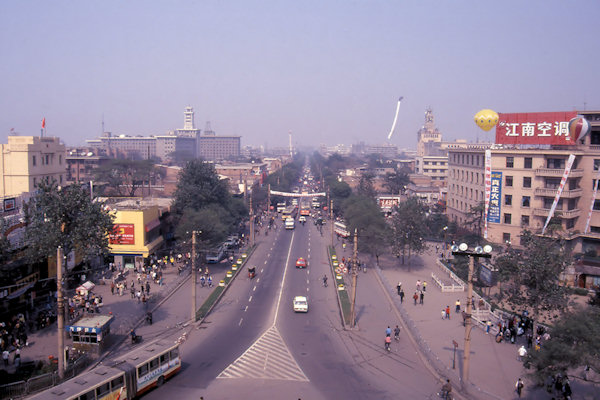 |
|||||
Xi'an is one of the few old cities in China where old city walls are still visible.
The walls were built on the foundations of the walls of the Tang Forbidden City during the reign of Hong Wu, first emperor
of the Ming dynasty in the 14th century
They form a rectangle with a circumference of 14 km. On each side of the wall is a gateway, and over each stands three towers.
At each of the four corners stands a watchtower, and at the top of the wall is punctuated with defensive towers.
Lianhu Park was built as a royal garden by the second son of Zhu Yuanzhang (the first Emperor of the Ming Dynasty 1368-1644),
covering an area of 18 hectares.
To the west of the North Lake, there is also a Water World. There are slides, boats for people to relax in, as well as a children's
playground.
 |
|||||
The Bell Tower is a hudge building in the centre of Xi'an that you enter through an underpass on the north side of the
tower.
The original tower was built in the late 14th century, but was rebuilt at the present location in 1739 during the Qing Dynasty.
A large iron bell in the tower used to mark the time each day, hence the name.
Located northwest of the Bell Tower is the "sister building" the Drum Tower. The drums were used to signal the running of
time and on occasion were used as an alarm in emergency situations.
It was initially built in 1380 during the reign of Emperor Hongwu of the Ming Dynasty, and was renovated twice in 1699 and 1740 in
the Qing Dynasty.
The tower marks the Muslim Quater of Xi'an where the narrow streets are lined with old mud-brick houses and where you can find
several food and souvenir market.
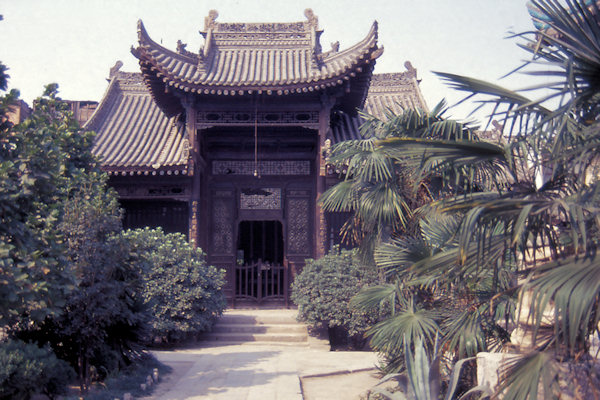 |
|||||
There are about ten mosques in the area of the Muslim Street, among which the Great Mosque is the most famous and popular.
The present buildings only date back to the middle of the 18th century, though the mosque might have been established several hundred years
earlier. It is built in a Chinese architectural style with most of the grounds taken up by gardens.
Originally built in 652 during the reign of Emperor Gaozu of the Tang Dynasty, Giant Wild Goose Pagoda functioned to
collect Buddhist materials that were taken from India by the traveling mong Xuan Zang, who then set about translating them
into 1335 Chinese volumes.
The impressive, fortress-like wood-and-brick building rises 64 metres.
Shaanxi Provincial History Museum was built in 1983 and opened to the public in 1991.
The museum is divided into the two major parts, the cultural relic reservoir area and the exhibition hall area.
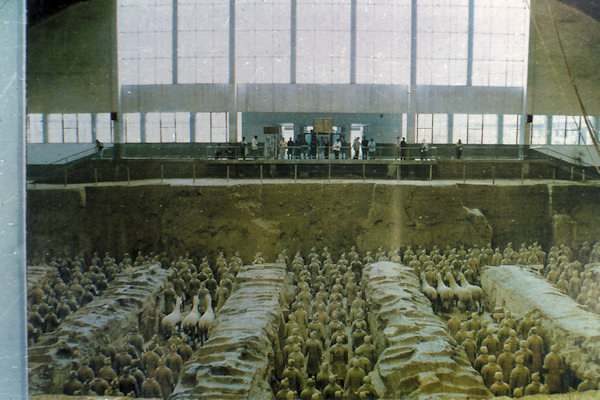 |
|||||
In the year 246 BC, at the age of 13, Ying Zheng ascended the throne of the state of Qin and assumed the title "Shi Huang"
or First Emperor. The emperor united the country, standardising currency and written script.
He also burned books and was a cruel tyrant who was secretive and suspiciousin his last days, fearing assassination and searching for an
elixir of immortality.
Quin Shi Huang's tomb is covered by a hudge mound of earth and has not been excavated.
In 1974 peasants digging a well about 1.500 metres east of the tomb uncovered one of the greatest archaeological sites in the world.
Excarvation of the underground vault of earth and timber revealed thousands of life-sized terracotta warriors and their horses in
battle formation - a whole army which would follow its emperor into immortality.
In 1976, two other vaults were discovered close to the firts one, but each of these was refilled with soil after excavation.
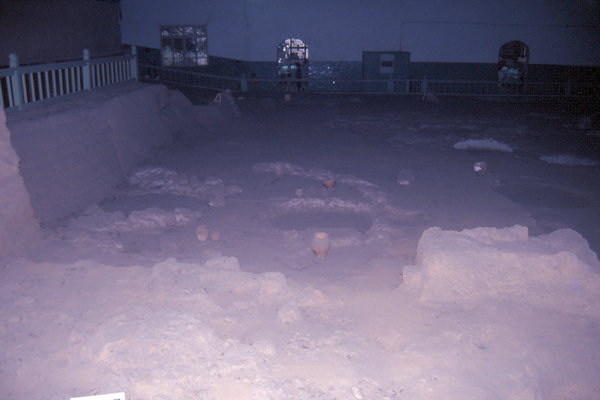 |
|||||
The Yangshao culture was a Neolithic culture that existed extensively along the Yellow River in China.
The oldest Yangshao-type village is Bampo, which appears to have been occupied from 4500 BC until around 3750 BC.
The village was discovered in 1953 and is on the eastern bank of the Chan river in a suburb of Xi'an.
A large hall has been built over what was part of the residential area of the village, and there are adjacent buildings housing pottery
and other artefacts.
It's said that King You first built a palace during Western Zhou Dynasty (1046-771 BC) at the foot of Mount Li.
In later dynasties, additions to the palace had been made. During his reign, the Tang-emperor Xuanzong (713-756 AD) spent
dizzying amounts of his funds to expand it to a luxurious palace named Huaqing Palace.
There are four hot springs in Huaqing Palace.
Beijing
Although the area south-west of the city was inhabited by cave dwellers some 500.000 years ago, the earliest records of settlements
date from around 10000 BC. It developed as a frontier trading town for the Mongols, Koreans and the tribes from Shandong and Central
China.
By the Warring States Period (476-221 BC) it had grown to be the capital of the Yan Kingdom and was called "Ji", a
reference to the marshy features of the area.
The town underwent a number of changes as it acquired new warlords, the Khitan Mongols and the Manchurian Jurchens tribes
among them. What attracted the conquerors was the strategic position of the town on the edge of the North China Plain.
History really gets under way in 1215 AD, the year that Gengis Khan thoroughly set fire to the preceding paragraph and slaughtered
everything in sight. By 1279 Genghis's grandson Kublai had made himself ruler of most of Asia and Khanbaliq (modern-day
Beijing) was his capital.
An uprising led by the mercenary Zhu Yuanzhang who took Khanbaliq in 1368 and ushered in the Ming Dynasty (1368–1644).
In the early 1400s Zhu's son Young Le renamed the city Beijing (Northern Capital). Many of the structures like the
Forbidden City and the temple of Heaven were first built in Young Le's reign.
The first change of government came with the Manchus, who invaded China and established the Qing Dynasty (1644–1912).
Under them, and particularly during the reigns of the emperors Kangxi and Qianlong, Beijing was expanded and renovated
and summer palaces, pagodas and temples were built.
In the last 120 years of the Quing dynasty, Beijing and subsequently China were subjected to the afflictions of power struggles, invaders
and the chaos created bt those who held or sought power; the Anglo-French troops who in 1860 marched in and burnt the Old Summer
Palace to the ground; the corrupt regime under Empress Dowager Cixi; General Yuan Shikai; the Warlords; the
Japanese who occupied the city in 1937; followed by the Kuomintang after the Japanese defeat.
A century of turmoil finally ended in januari 1949 when troops of the People's Liberation Army entered the city. On 1 october
of that year Mao Zedong proclamed a "People's Republic" to an audience of some 500.000 citizens in Tiananmen Squire.
Tiananmen Square is the heart of Beijing, a vast desert of paving and photo-booths.
The last major rallies took place here during the Cultural Revolution when Mao, wearing a Red Guard armband, reviewed parades of up to
a million people. In 1976 another millien people jammed the square to pay their last respects to him.
In 1989, army tanks and soldiers cut down pro-democracy demonstrations here.
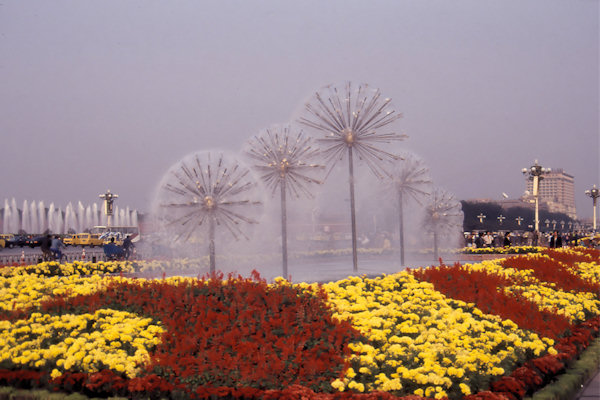 |
|||||
Today the square is a place, if the weather is conductive, for people to lounge around in the evening, and a place to fly decorated
kites and balloons for the kiddies.
The granite Monument to the People's Heroes built in 1952, it is the largest monument in China's history. The People's Heroes "
are Immortal" written by Chairman Mao is engraved on the monument.
Memorial Hall of Chairman Mao is at the south side of Tiananmen Square.
At the north end of the Square is Tiananmen Tower. Initially built in 1417 during the Ming Dynasty, the Square
was the front door of the Forbidden City. The most important use of it in the past was to declare in a big ceremony to the common
people who became the emperor and who became the empress.
Qianmen is situated to the south of Tiananmen Square and once guarded the southern entry into the Inner City. Although much of
Beijing's city walls were demolished, the gate remains an important geographical marker of the city.
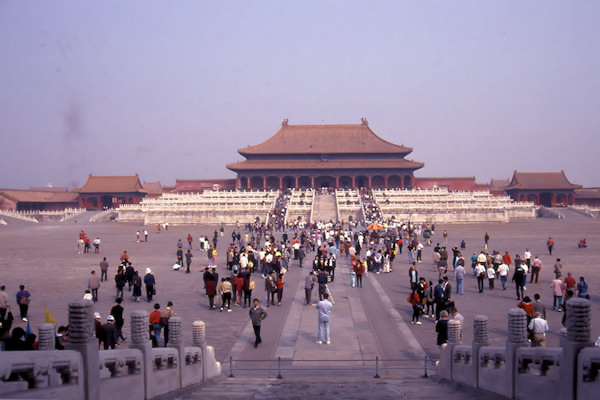 |
|||||
The Forbidden City, so called because it was off limits for 500 years, is the largest and best preserved cluster of ancient
buildings in China. It was home to two dynasties of emperors, the Ming and the Qing, who didn't stray from this
pleasure-dome unless they absolutely had to.
The Hall of Supreme Harmoney is the most important and the largest structure in the Forbidden City. It was used for ceremonial
occasions such as the emperor's birthday, the nomination of military leaders, and coronations. Inside the hall is richly decorated
Dragon Throne where the emperor would preside (decisions final, no correspondence entered into) over trembling officials.
The Palace of Heavenly Purity was built in 1420 and rebuilt in 1798 as a consequence of fire damage. Ming emperors and the first
two Qing emperors lived in and attended to daily affairs of state.
On the northern end of the Forbidden City is the Imperial Garden, a classical Chinese garden with rockeries, walkways and
pavillions.
Built in 1772 the Nine Dragon Screen depicts nine writhing dragons playing with pearls against a background of the sea and clouds.
Originally, the Temple of Heaven was the place where emperors of the Ming Dynasty and Qing Dynasty held the Heaven Worship
Ceremony. First built in 1420, the 18th year of the reign of Emperor Yongle of the Ming Dynasty, the Temple of Heaven was enlarged
and rebuilt during the reigns of the Ming emperor Jiajing and the Qing emperor Qianlong.
It is set in a 267-hectare park with four gates at the compass points and bounded by walls to the north and east.
It originally functioned as a vast stage for solemn rites performed by the "Son of Heaven" who came here to pray for good harvests,
seek divine clearance and atone for the sins of the people.
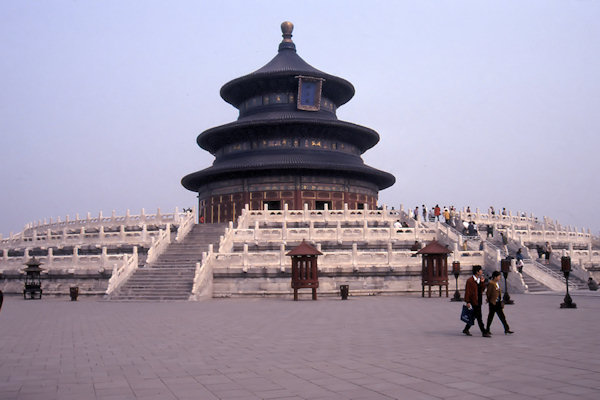 |
|||||
The Hall of Prayer for Good Harvests is a circular building which is 32 meters in diameter and 38 meters high, sitting on a
huge round white marble platform named Altar for Grain Prayers. Covering over 5.900 square meters, the altar has a height of
six meters, consisting of three floors; each of which is surrounded by carved white marble railings. The stairs connecting each floor
are decorated with huge relief. It's here the emperor held the worship ceremonies to pray for good weather and abundant harvests.
The Imperial Vault of Heaven is the place housing the Gods' tablets to be used at the Heaven Worship Ceremony.
The Circular Altar Mound is actually the Temple of Heaven in the practical sense. During the Ming and Qing Dynasties, the emperors
would offer sacrifice here to Heaven on the day of the Winter Solstice every year.
Before the worshipping ceremony, a washed and shaved calf would be put on the Firewood Stove and burned with pine twigs and reeds.
After the ceremony, all the offerings, ceremonial placards and silk scrolls were respectfully put inside the stove to be burned.
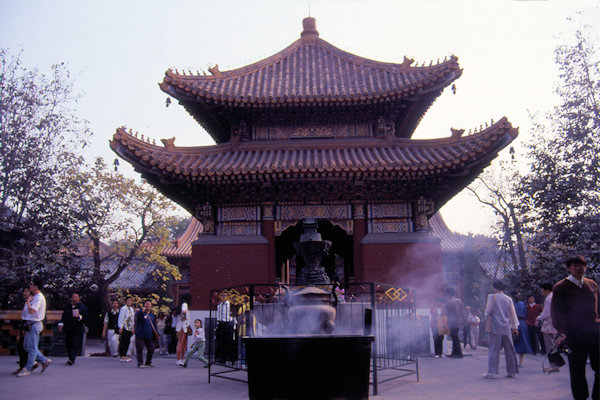 |
|||||
The Yonghe Temple ("Palace of Peace and Harmony"), popularly known as the Lama Temple, is a temple and monastery of the
Gelug school ("Yellow Hat") of Tibetan Buddhism. The building and artwork of the temple is a combination of Han Chinese
and Tibetan styles.
The temple was built in 1694, the 33rd year during the reign of Emperor Kangxi in the Qing Dynasty. It was originally the residence
of Prince Yong (the fourth son of Emperor Kangxi) and half of it was converted to a lamasery after Prince Yong ascended the
throne.
In 1735 when Emperor Yongzheng passed away, his coffin was placed in the temple. The next Emperor Qianlong ordered to change the
turquoise tiles of the main halls in Lama Temple to yellow tiles. This has greatly enhanced its status because yellow is the color
exclusive to emperors at that time.
In 1744, Yonghe Temple was transformed into a formal Tibetan Buddhist temple and became the center of lama administration of the Qing
government.
See my Younge Temple-page for more information.
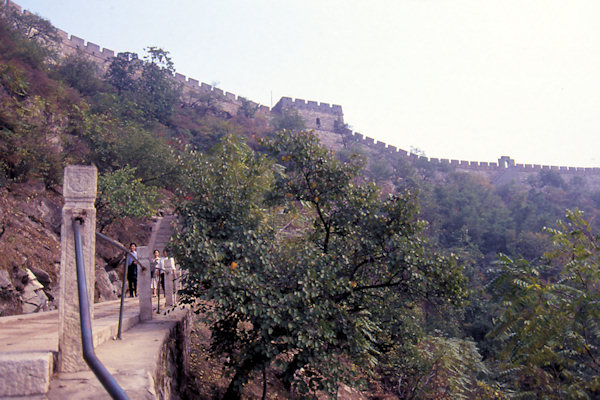 |
|||||
The Great Wall of China was built mainly during the three dynasties – Qin Dynasty (221-206 BC), Han Dynasty
(202 BC – 220 AD) and Ming Dynasty (1368–1644 AD).
Actually the history tells us the Great Wall played no effective role in preventing the “barbarians”. Rarely did the Wall stop
any invasions, large or small.
But the Great Wall did do many things: it proclaimed the frontier, it employed the thousands, it prevented defections, it displayed
the mighty of the emperor and provided numerous frontier areas for trades.
The wall best can bee seen at Badaling, about70 km nort-west of Bijing.
The Summer Palace is a vast ensemble of lakes, gardens and palaces about 12 km north-west of Beijing. It was an imperial garden
in the Qing dynasty.
Mainly dominated by Longevity Hill and Kunming Lake, it covers an expanse of 2.9 square kilometres, three-quarters of
which is water.